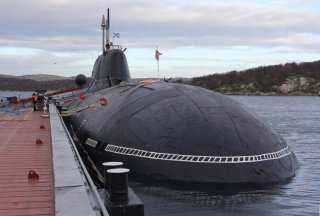Akula-Class Submarines are the Backbone of Russian Naval Power
In due time, the entire Akula line is projected to be replaced with the Yasen-class—formally Yasen-M, following a deep modernization effort in 2009—of nuclear-powered cruise missile submarines.
Here's What You Need to Remember: No more than three original Akulas are still in service, while all six of the improved Akulas are either currently serving or undergoing refits to return to service in the near future. Despite being kept on the Russian Navy’s roster for the time being, the actual condition and combat-ready status of the older Akula boats remains unclear. Earlier this year, it was revealed that certain Akula models are being upgraded to launch Russia’s new Kalibr cruise missiles—the list of Kalibr-compatible Akula submarines is currently limited to Vepr.
A formidable showcase of late Soviet submarine design, the Akula remains the backbone of Russia’s nuclear-powered attack submarine force over three decades after its introduction.
By the late 1970s, the Soviet Navy concluded—in no small part, from information provided by Soviet spies embedded in the U.S. Navy—that Soviet submarines are seriously lagging behind their U.S. counterparts in stealth capabilities. The Viktor III line had already taken small steps in this direction, but the Soviet command structure decided that further stealth performance improvements were needed for the next generation of Soviet nuclear attack submarines.
Project 971—NATO reporting name Akula, not to be confused with the Soviet Akula-class SSBN (NATO reporting name Typhoon)—entered production in 1983. A hefty boat, the Akula featured a submerged displacement of around thirteen thousand tons and was built in the signature steel double-hull style typical to Soviet submarines of that period. The Akula boasted four 533-millimeter torpedo tubes and four large 650-millimeter tubes for a total of forty torpedoes, also capable of launching mines. The propulsion plant was isolated as a sound-reducing measure. With the help of recently-obtained premium Japanese propeller milling machines, Soviet engineers produced new, high-quality propellers for the Akula that all but eliminated the design deficiencies of their predecessors. The result was an impressive reduction in noise levels compared to older Soviet submarines. With the Akula, the Soviet Navy could now trade blows with the Los Angeles-class in stealth, thus eliminating the one performance category in which NATO submarines enjoyed an undisputed, overwhelming advantage over their Soviet counterparts.
The Akula-class underwent four major iterations. The improved Akula I (as compared with the original Akula I) models feature upgraded sensors, hull changes leading to more acoustics reductions, and two more 533-mm torpedo tubes for a total of six. The Akula II line was meant to offer further reductions in noise but proved too expensive to mass-produce at a reported price tag of 2.4 billion per model. The Akula III line, conceived amid the chaos of the Soviet collapse, didn’t fare much better. There were seven original Akulas and six improved Akulas. The Akula II and III projects yielded one submarine each—the Vepr and Gepard respectively—both of which are currently in service with Russia’s Northern Fleet after undergoing refits in the prior decade. No more than three original Akulas are still in service, while all six of the improved Akulas are either currently serving or undergoing refits to return to service in the near future. Despite being kept on the Russian Navy’s roster for the time being, the actual condition and combat-ready status of the older Akula boats remains unclear. Earlier this year, it was revealed that certain Akula models are being upgraded to launch Russia’s new Kalibr cruise missiles—the list of Kalibr-compatible Akula submarines is currently limited to Vepr.
In due time, the entire Akula line is projected to be replaced with the Yasen-class—formally Yasen-M, following a deep modernization effort in 2009—of nuclear-powered cruise missile submarines.
Mark Episkopos is the new national security reporter for the National Interest. This article is being republished due to reader interest.
Image: Wikipedia.

